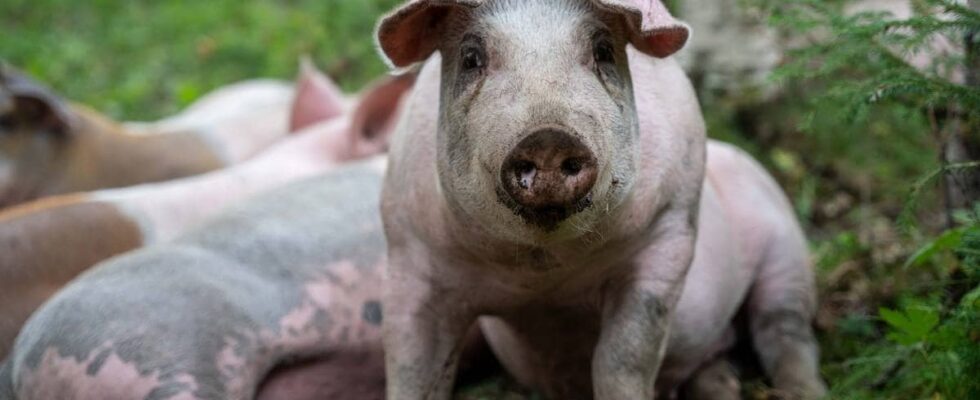Let it be beyond doubt: Pigs cannot fly. What they can do, however, is make sounds. For over ten years, researchers have worked to understand the pigs’ “sniff”, grunts and squeals. With the help of thousands of sound recordings and artificial intelligence, they should have been able to interpret what the pigs feel, based on the situations they find themselves in. – Pigs are ideal because they are very vocal in all kinds of situations, says Elodie Mandel-Briefer to news. A little pig looks up over a fence. Photo: Image Source She is an associate professor at the University of Copenhagen, and researches the development of vocal expressions of emotion in animals. – By training an algorithm to recognize the sounds, we can place 82 percent in the right emotions. Organic pigs more stressed In a new documentary broadcast on Danish DR, more than 15,000 pig sounds from nine farms in Denmark and Germany have been interpreted. The footage was taken in various situations, such as when the pigs were fighting for food, or when they were playing. A pig with a curl on its tail. Photo: Tordis Gauteplass / Tordis Gauteplass – What we saw was that the grunts changed in relation to the situation. We actually saw 19 different levels of emotion in the pigs, says Mandel-Briefer. Facts In 2022, the researchers published a study in Scientific Reports, based on over 7,000 recordings from various situations, which, based on the pigs’ behavior, were associated with a positive or negative feeling. Using this database, they were able to train an algorithm to interpret the pigs’ sounds in the various situations. While high-frequency, long-lasting howls occurred more often in negative situations, lower-frequency and short grunts were more common in positive and neutral situations. Positive situations included breastfeeding, reuniting with family after separation, getting food or playing and exploring the surroundings. The pigs experienced fear or stress when they were isolated, in fights, during castration or when they were sent for slaughter. They also expressed negative emotions more often when standing still or trying to run away from something. The documentary from DR is based on new footage. Here, with the help of the researchers, more than 15,000 pig sounds have been analysed. A new study article of these results has not yet been published. These emotions were divided into three main categories: Stressed, satisfied or sad. What surprised the researchers was that on two out of three organic farms the pigs were more stressed than on the conventional ones. This despite the fact that organic pigs have more room to romp and access to outdoor areas. On average, the pigs on the conventional farms expressed stress in a quarter of the cases. For the organic pigs, the average was 36 per cent. Free-range pigs that lived outdoors, on the other hand, were far more satisfied. On average, 7.6 percent of stress grunts were recorded on these farms. However, the measurements are not unambiguous, and there were large differences from farm to farm. For example, the traditional farms had almost as many happy pigs as those with free-ranging animals. – In fact, it was a conventional farm that had the happiest pigs. We saw that the farmer seemed to have a good relationship with the pigs, and handled them very carefully, says Mandel-Briefer. – It was also the only farmer who allowed filming on the farm. Can improve welfare The aim of the research is to give farmers a tool to understand how their pigs are doing in the pen, says Mendel-Briefer. – Emotions are at the center of animal welfare, but currently most, if not all, automated tools for assessing welfare on farms are based on physical health, not mental health. There is already a lot of research into pigs’ expression of pain. Kristian Ellingsen-Dalskau, researcher on animal welfare at the Veterinary Institute, sees a growing trend in studies on more positive welfare. – The old definition of animal welfare was that as long as health is good, welfare is good. It has now been realized that it is no longer enough. The pig’s ability to perform natural behavior and cognitive state also play a role. Photo: Eivind Røhne He emphasizes that it is entirely possible to have good welfare indoors, if the pigs have enough space and stimuli. – But pigs are social animals, and need to use their heads and bodies. There are better opportunities for this out there, he says. – Outdoor farming, however, introduces more challenges with the risk of infection and monitoring, and demands more from the system and the farmer. Ellingsen-Dalskau believes that an automated system that monitors the pigs’ state of mind can provide better welfare. But it cannot replace the pig farmer himself. – I think the vast majority of farmers already understand what the various sounds of their animals mean. The challenge is that farmers have many tasks and limited time and therefore do not have time to listen to each and every one. Published 14.09.2024, at 09.41
ttn-69
Scientists think they can understand the emotions of pigs – news Urix – Foreign news and documentaries

